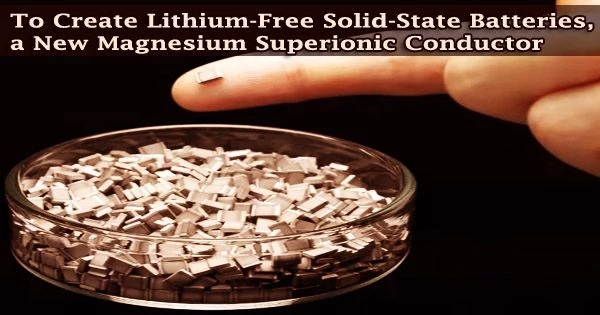High-capacity, economical batteries are more necessary than ever as we work to become an energy-efficient society. Due to its abundance, magnesium is a viable material for these solid-state batteries, but its practical applicability is restricted by the magnesium ions’ (Mg2+) poor conductivity in solids at ambient temperature.
Japanese scientists recently overcame this decades-long obstacle by creating a unique Mg2+ conductor with a usable superconductivity of 10-3 S cm-1. A sustainable future depends on the creation of extremely effective energy storage technologies that can store renewable energy.
The most advanced batteries available today are solid-state rechargeable lithium ion (Li+) batteries. However, because of society’s reliance on lithium, a rare earth metal, resources are anticipated to dwindle quickly, pushing up prices.
As an alternative to Li+ batteries, magnesium ion (Mg2+)-based batteries have gained popularity. Magnesium is abundant in the earth’s crust, and systems based on Mg2+ are believed to have high energy densities, great safety, and low costs.
The weak conductivity of Mg2+ in materials at normal temperature, however, restricts its wide range of applications. Due to the strong interactions that divalent positive ions (2+) have with their nearby negative ions in a solid crystal, which prevent them from moving through the substance, Mg2+ has a low solid-state conductivity.
A research team from the Tokyo University of Science (TUS) recently overcame this hurdle.
For a long time, people have believed that divalent or higher valency ions cannot be efficiently transferred through a solid. In this study, we have demonstrated that if the crystal structure and surrounding environment are well-designed, then a solid-state high-conductivity conductor is well within research.
Dr. Masaaki Sadakiyo
They disclose for the first time a solid-state Mg2+ conductor with superionic conductivity of 10-3 S cm-1 (the threshold for practical application in solid-state batteries) in their new work, which was published online on May 4 and in print on May 18 in volume 144 issue 19 of the Journal of the American Chemical Society. The highest conductivity for Mg2+ conductors has ever been recorded.
Study leader Masaaki Sadakiyo, a junior associate professor at TUS, said, “In our work, we exploited a family of materials called metal-organic frameworks (MOFs). Due to the very porous crystal structures of MOFs, the incorporated ions can move through them effectively. Here, we additionally introduced a “guest molecule,” acetonitrile, into the pores of the MOF, which succeeded in strongly accelerating the conductivity of Mg2+.”
The research group further included Mr. Yuto Yoshida, also from TUS, Professor Teppei Yamada from The University of Tokyo, and Assistant Professor Takashi Toyao and Professor Ken-ichi Shimizu from Hokkaido University.
The paper was made available online on May 4, 2022 and was published in Volume 144 Issue 19 of the journal on May 18, 2022
The MIL-101 MOF was employed as the primary framework, and Mg2+ ions were subsequently enclosed in its nanopores. The Mg2+ was loosely packed in the resulting MOF-based electrolyte, allowing the migration of divalent Mg2+ ions.
The study team exposed the electrolyte to acetonitrile vapors, which were adsorbed by the MOF as guest molecules, to further improve ion conductivity.
The team next performed an alternating current (AC) impedance test on the prepared samples to gauge ionic conductivity. They discovered that the superionic conductivity of the Mg2+ electrolyte was 1.9 × 10-3 S cm-1.
This is the highest conductivity for a crystalline solid containing Mg2+ that has ever been recorded. The researchers measured the electrolyte’s adsorption isotherm and infrared spectroscopic properties in order to comprehend the mechanism underlying this high conductivity.
The experiments showed that the acetonitrile molecules adsorbed in the framework enabled the Mg2+ ions to move through the solid electrolyte’s body with efficiency.
These research’s conclusions not only show that the innovative MOF-based Mg2+ conductor is a good material for batteries, but they also give important information about how solid-state batteries will be developed in the future.
“For a long time, people have believed that divalent or higher valency ions cannot be efficiently transferred through a solid. In this study, we have demonstrated that if the crystal structure and surrounding environment are well-designed, then a solid-state high-conductivity conductor is well within research,” explains Dr. Sadakiyo.
When asked about the research group’s future plans, he reveals, “We hope to further contribute to society by developing a divalent conductor with even higher ionic conductivity.”





